What are hermits?
For a good time, I collected and analyzed ("read") as many books and articles on the topic of hermits as I could, and I did this for the purposes of simply learning about hermits and hermitages. What did I learn? Simply put, my understanding of what hermits was re-enforced. Hermits are solitary people -- usually men -- and they are usually interested in delving into religious experiences. Along the way I also learned a bit about hermit crabs.
TLDNR; A hermit would be no hermit without a skull.
Bibliographics and extracted features
I collected about 170 bibliographic items -- book or journal articles, and one can peruse them in a computed bibliography. The whole collection is about 9 million words long, thus, relatively speaking, the collection is approximately the size of 11 Bibles. They date from 1495 to the present, with the vast majority of them dating from 1810 to 1930.
The most frequent extracted features (words, two-word phrases, parts-of-speech, etc.) include words such as I, man, time, old, hermit, day, I think, I know, young man, old man, God, lord, other, great, London, England, France, Japan, home, life, mind, and heart. A summary of these things, complete with simple visualizations, is a bit more informative.
The Company of words: Distant reading
A linguist named John Firth once said, "You shall know a word by the company it keeps." If I take this statement to be true, then it behooves me evaluate what words are associated with my word of interest. I am interested in the word "hermit", and I can extract all the bigrams -- two-word phrases -- which include the word "hermit". I can then visualize the result in the forms of a word cloud or network graph. I believe the network is more informative, and it illustrates what words are used in common with hermit-esque words. The hermit-esque words include "hermit", "hermits", "hermitages", etc. And they have a set of words in common: poor, wild, life, holy, brother, solitary, etc.
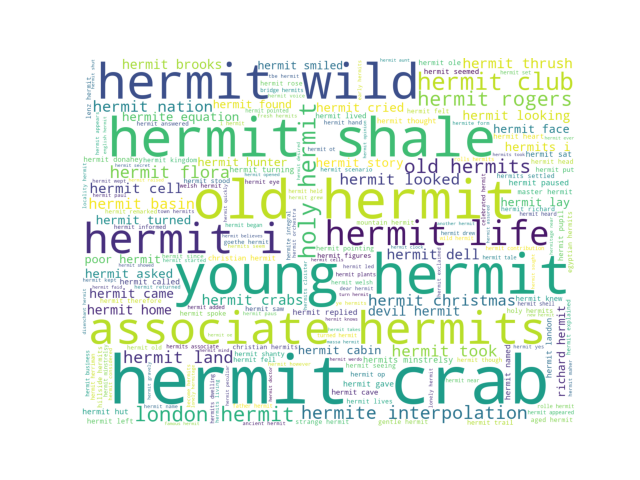
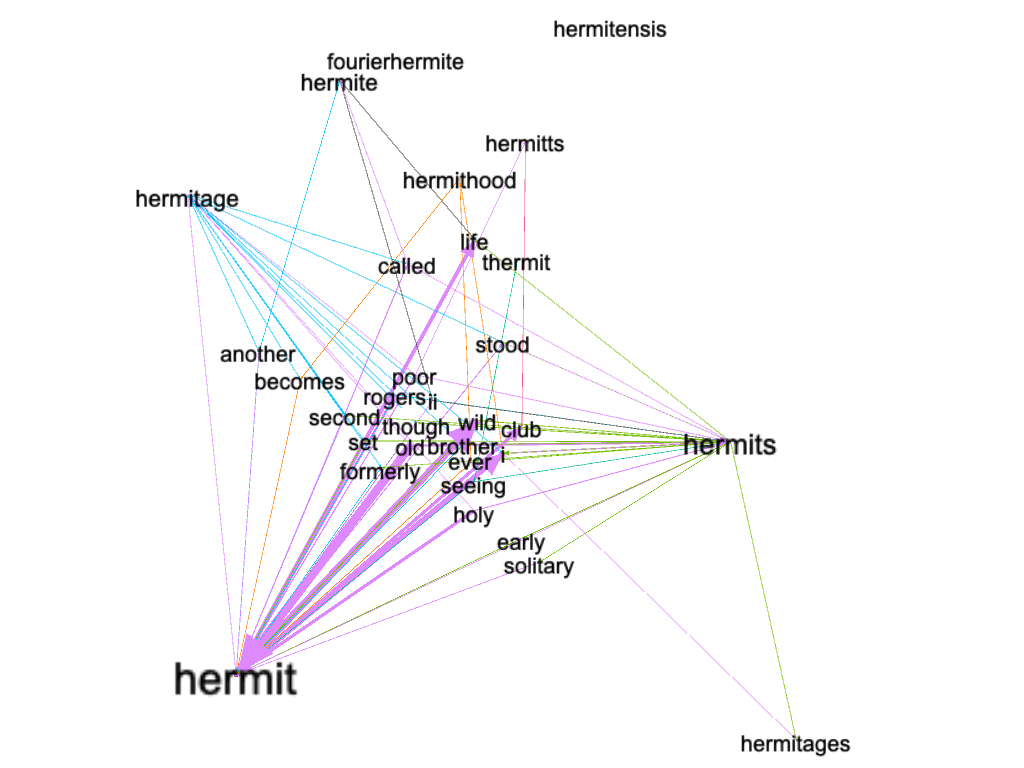
Topic modeling is another way to compute what words are in the company of others. I applied topic modeling to the corpus, and for the sake of simplicity, I denoted 12 as the number of clusters ("topics") to return. Thus, I assert the whole corpus is about time, love, hermits, etc. Moreover, the topics of time, love, and hermit predominate:
labels weights features
time 0.44158 time man day country house life place people s...
love 0.32503 love heart life old god light man day eyes sou...
hermit 0.29516 hermit man old time back think came way young ...
japanese 0.10698 japanese corea corean chinese north new japan ...
nigel 0.10632 hermit nigel water time moses captain dat der ...
god 0.09616 god man holy saint came father life church tim...
cleveland 0.09515 cleveland ruth new company archibald hermits h...
moira 0.05946 hermit moira foucauld birds charles nest found...
species 0.04922 species specimens surface length specimen vol ...
und 0.04211 hermit und der edith fred die life robert natu...
rolle 0.03999 rolle richard english john parliament monks na...
man 0.01990 man time hermit fome young quarll faid ſhe fuc...
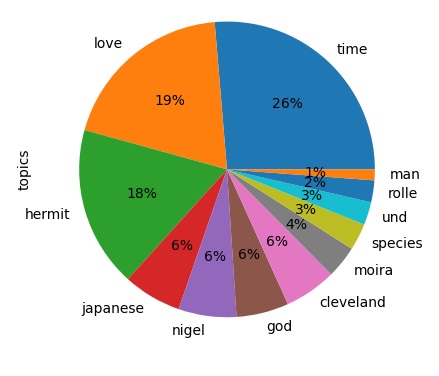
computed topics
There are grammatical relationships between words, and the most well-understood relationships are synonomy (similarity) and antonymy (opposition). A language model called WordNet asserts many more relationships, and one of them is hypernym -- denoting a broader term in a hierarchy of terms. Given the words from the topic modeling process I can discover the common hypernyms (if they exist) between each & every word in the topic modeling output. I can then illustrate the result as another network graph. If I use my imagination, I believe I can see sets of quantities, parts, persons, nature, organizations, and locations:
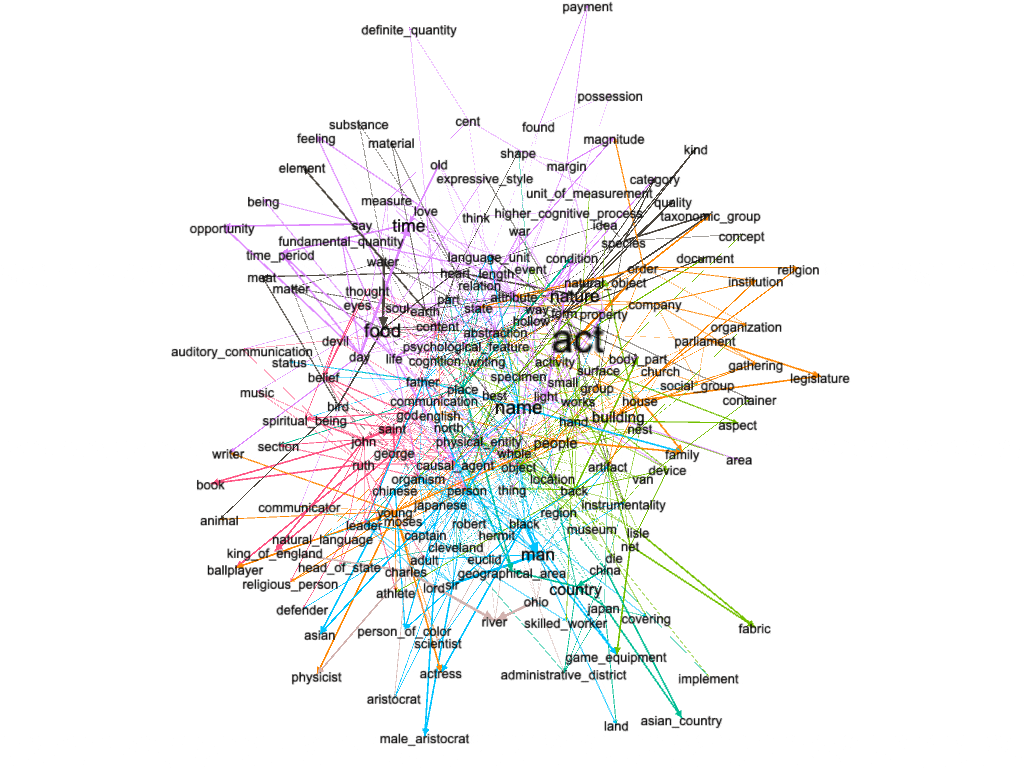
hypernyms rooted in the computed topics
The application of semantic indexing is yet a another way to calculate and visualize what words are used on conjunction with others. By plotting the position of words in an n-dimensional space, one can calculate the (cosine similarity) distance between any two words, and words whose distances are smaller than a given threshold can be denoted as nearby. This process can be then be applied recursively to create a network. For example, using this technique the words closest to the word hermit are: martin, hermits, hollow, hunter, sage, godric, recluse, secluded, finchale, and mystery. I believe these words belie the fact that many of items in the collection are fiction as opposed to non-fiction. Applying this process recursively results in the following network diagram:
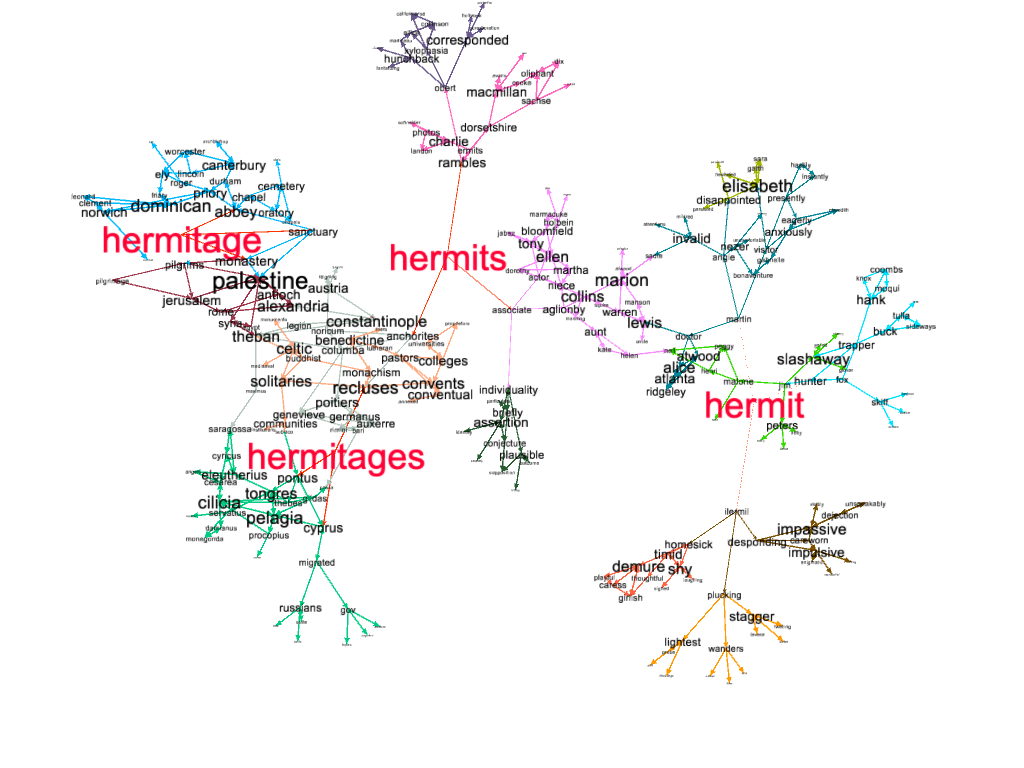
semantic relationships
Closer reading
Metaphorically speaking, the previous exercises are techniques of distant reading or "looking at the forest", but now I will try to apply close reading or "looking at the trees". This is accomplished through full-text indexing, concordancing, and sentence extraction. For example, after indexing the collection and then searching for items whose titles, summaries, and computed keywords all contain the word "hermit", a list of 15 items is returned, much less than the 170 items in the entire collection. Items appearing nearer the top of the list are considered more relevant:
- Hermit In Prison / Jouy, Étienne (1823) - HathiTrust version
- Modern Hermit / Bell, H. J. S. (1899) - HathiTrust version
- Hermit Of Turkey Hollow / Train, Arthur (1921) - HathiTrust version
- Hermit Of Holcombe... / Chellis, Mary Dwinell (1871) - HathiTrust version
- Wanderings Of The Hermit Of Westminster On The Continent / Spice, R. P. (1880) - HathiTrust version
- Life And Adventures Of Robert, The Hermit Of Massachusetts... / Trumbull, Henry (1829) - HathiTrust version
- Hermit Of Eskdaleside / Merryweather, I. A. (1833) - HathiTrust version
- Hermit's Dell / Wetmore, Henry Carmer (1854) - HathiTrust version
- In The Hermit Land / Williams, Henry F. (1912) - HathiTrust version
- Old Mountain Hermit / Raymond, James F. (1904) - HathiTrust version
- Hermit Of Moss Pond / Pitcher, James (1896) - HathiTrust version
- Devil Turn'd Hermit / Lambert de Saumery, Pierre (1741) - HathiTrust version
- Narrative Of The Extraordinary Life Of John Conrad Shafford... (1840) - HathiTrust version
- Wanderings Of The Hermit Of Westminster... / Spice, R. P. (1884) - HathiTrust version
- Three Girls And A Hermit / Conyers, Dorthea Smyth (1908) - HathiTrust version
Concordancing is a quick & easy way to see how words/phrases are used in the context of a text, and concordancing for the phrase "hermits are" returns the following result:
ut prattling to himself as conventional hermits are supposed to do. and his shanty was no c
the baroque novel, simplicissimus, the hermits are closely related to the characters upon
mm, trost der nacht, o nachtigal!" both hermits are heard singing the songs which character
here there wasn't treasure? that's what hermits are for—to guard a treasure.” “well, maybe,
ubjects from the lives of the two first hermits are the temptation of st. antony, his meeti
the best made custom shirts a bunch of hermits are wearing them watson sixth city shirt ma
service the cleveland telephone co. the hermits are in vienna, but after the play will be f
land taxicab service they enjoy at home hermits are discriminating. they want more than a m
the new auto fuel get aboard-all ୧୧ the hermits are next" the energine co-cuyahoga bldg.cle
s both phones maker 110 euclid ave. the hermits are secluded so are we'l they are being dis
e -the new auto fuel get aboard-all the hermits are next the energine co-cuyahoga bldg.clev
en subject of conversation. try it. the hermits are seldom seen. here's hoping we may see m
. arter in the hermits in africa 72 the hermits are going some so are davis & farley! why d
electric building, cleveland, ohio the hermits are all wearing stone's shoes how about you
here there wasn't treasure? that's what hermits are for--to guard a treasure." "well, maybe
in the hermits at happy hollow 138 the hermits are going some so are davis & farley! why d
t. 5858 cleveland, o. longer's like the hermits are great on the parisian stuff models arri
oy tonneau runabout for recreation, the hermits are automobilists. and they know good cars.
ter all, that may well be the case, for hermits are noted for the frugality of their fare."
done me any good yet and may not. these hermits are likely to live long. their habits are r
ter all, that may well be the case, for hermits are noted for the frugality of their fare."
nfra, p. 507). very many anchorites and hermits are remembered by name. a large legacy of b
Unfortunately, concordancing is a brute force technique relying solely on syntax; zero elements of semantics are applied in concordancing. Yet phrases such as "hermit is", "hermitages are", "hermits were" can be very informative. Moreover, we can truncate the results of concordancing, and sort the results to get quick & dirty definitions. Some of the more interesting, to me, are listed below:
- hermits were wise
- hermit was in hell
- hermit was a franciscan
- hermits are discriminating
- hermit is apparently studying
- hermit is as poor as job's turkey
- hermit is persecuted by a deluded society
- hermit was long greatly venerated in england
- hermit is not a priest, nor is he a preacher
- hermit is the interpreter of the almighty will
- hermit is characterized by the sense of timelessness
- hermit is transcribing the orthodox manual pars oculi
I can get around the syntactical limitations of concordancing by extracting sentences instead of snippets. Algorithmically I can: 1) segment the corpus into sentences, 2) optionally define a desired grammar, 3) optionally identify sentences matching the grammar, and 4) filter the result by supplying nouns and verbs. For example, I'm still interested in the definition of hermits and hermitages. Thus my nouns (lexicon) will be "hermit", "hermits", "hermitage", and "hermitages". My verbs are rooted in the word "be", and thus my verbs will be "is", "was", "were", etc. Finally, I will define desirable sentences to be in the form of <noun phrase><verb><noun phrase>. Thus I expect to get sentences akin to "Hermits are _____." Similarly, modal verb (verbs prefixed with words like "should", "could", "ought", "can", etc.) are very telling. By combining all the techniques outlined in this paragraph, a long list of sentences about hermits was generated. Some of the more interesting results include:
- These hermits are likely to live long.
- A hermit would be no hermit without a skull.
- Does she think the hermit is a starving pauper?
- A hermit is more truly himself than any other man.
- That's what hermits are for--to guard a treasure."
- The very pope of hermits was the Hermit of Bellyfulle.
- Well, I must say your friend the hermit is a gentleman.
- The hermit has a horror of what is now called centralization.
- As in Goethe's play, the hermit is the embodiment of its spirit.
- "Because the hermit was absent, off on one of his crazy rambles."
- "If the hermit is not Old Nick himself, he must be a near relation.
- Only the hermit is intimately acquainted with the timelessness of the retreat.
- Of all these results, Peter the hermit was the unconscious forerunner and prophet.
- Indeed, hermits were regarded as heroes, because of the physical hard ness they endured.
- [Illustration: The hermit was much moved, as he took the boy in his arms and kissed him.]
- Road and bridge hermits were still doing useful work, and were popular objects of charity.
- After all, that may well be the case, for hermits are noted for the frugality of their fare."
- You may imagine the hermit was rejoiced, when he had the precious lamp again in his own hands.
- Both hermits are heard singing the songs which characterize their states of existence before they are seen.
- Although there seems to be no re cord of actual canonization, the hermit was universally regarded as a saint.
- Goethe's hermit has the profound world of nature, "Gottes Stadt", which he can substitute for that which he left.
- In fact, the hermits were pioneers of philanthropic works which in these days are under taken and carried out by public bodies.
- "I thought the poor old hermit was merely wandering in his mind when he talked about men being after him, but, it seems he was right.
- The essence of the poem is rather in the attack upon false piety and the empty display of virtue; the hermit is the instrument of this attack.
- The pathological emotion of the hermit is evident in the last attempt to persuade himself that his long life as a recluse has not been in vain.
- For a wonder, the hermit had a companion, not an exploring amateur or scientist, but a companion who said he meant to follow him into the desert.
- The Christian hermits were, however, by no means the first to withdraw from the world with a view to leading a life of solitary meditation and prayer.
- Among men of religion, the hermit is foremost, although his garden has proved a stumbling-block; whilst the anchorite is kept back by sloth, represented by a bed.
- As to the copes, the cosme of Hermits is a long gown with hood covering the whole body, with m-holes, a tunick, and rosary: beard ery long, but their dress was often gged.
- The first Christian hermit was a young man named Paul, a native of Thebes, who was born in the second half of the third century, and was left an orphan before he was sixteen.
- The figure of the hermit is the protagonist of Goethe, himself, while Satyros, the antagonist, is, perhaps, the Herder of Goethe's Strassburg period (Max Morris, Der junge Goethe, Vol.
- In Satyros, Goethe's hermit is the protagonist of a procreative nature as the revelation of divine purpose, which can be grasped only through individual experiencing nature and religion are, in a sense, one.
- "For two years this venerable hermit was my only companion, and much I learned from his sage experience; but I never could draw from him the secret of his own life, nor the reason why he had become a solitary.
- He looked earnestly into his friend's face as he spoke, but the hermit was quite unmoved, and there was not a shadow of change in the sad low tone of his voice as he said-"Yes, she was indeed beautiful, like her mother.
- The hermit had a little building on purpose, where there was a good fireplace, and a long beam for the feather-bags; the contents of which were perfectly sweet, and as downy and fluffy, as if they had never been wetted.
- This location indicates very plainly the poet's conception of him; dwelling farthest from man and society in the most intimate relationship to the creator, the hermit is the interpreter of the almighty will and protector of nature's inviolability.
- "Not far from hence, says the student in Don Quixote,e is an hermitage, where lives an Anchorite, who is said to have been a soldier.-Adjoining to the Hermitage is a little house, built by the labour of his own hands, which though narrow is large enough to receive travellers.
- The hermits were believed to have returned, by celibacy and penitence, to "the life of angels;" to that state of perfect innocence which was attributed to our first parents in Eden: and therefore of them cur Lord's words were true: He that believeth in me, greater things than these (which I do) shall he do."
- For he was neither a hundred years old with a bald pate and long white and long white whiskers like William Cullen Bryant or Father Time; nor did he mutter incantations over a seething caldron like the witches in Macbeth, or meander aimlessly about prattling to himself as conventional hermits are supposed to do.
- He went to the University of Oxford where, when he had made great progress in study, he desired more fully and more deeply to be instructed in the theological doctrines of Holy Scripture, rather than in physics or in the teaching of secular science The young hermit was no profound scholar, but he was well read.
- The sole motivation for life in Lenau's hermit is his desire, as we have said, to reexperience the past which has broken his life; this is evident, too, in his drive to tell his story, to bring it to life for the wanderer (the "Vermittler" of a horror tale in a manner similar to that of the monk in Grillparzer's Das Kloster bei Sendomir).
- Some hermits were, who dwell'd within a rock Hollow, indented in a sloping ground, Above, an ancient tree's inclining stock Spread branchy arms, that shaded all around, Its crooked roots for beams the loose roof bound; Before the entrance rude, a gentle stream Adown the vale its serpent courses wound, Seen here and there through breaks of trees to gleam, Gilding their dancing boughs with Noon's reflected beam.
- "I wonder," he muttered, in sleepy tones, "if that's a f--fam--'ly Bible he's reading--or--or--a vol'm o' the En--Encyclopida Brit--" He dropped off at this point, but, feeling that he had given way to some sort of weakness, he struggled back again into wakefulness, and saw that the hermit was bending over the large book with his massive brow resting on the palms of both hands, and his fingers thrust into his iron-grey hair.
"Yes, but what about crabs?"
Extracting some close reading sentences about hermit crabs is kinda fun:
- The crabs are constantly changing shells and if one obtains the dextral shell he does not as readily exchange it as he would a shell of other type.
- If the snail, while the crabs are pulling and picking at it, gets pulled out bodily, the vacant shell may indeed be taken by one of the diners, but more usually the «rabs devote their attention to the meat and leave the shell unnoticed.
- If a single right-handed shell is dropped into an aquarium where the crabs are in straight tubes or sinistral shells, it will in the long run be found and used — unless its size be utterly inadequate — even though the bottom is encumbered with empty shells of other sorts.
- Probably a large number of the anatomical peculiarities of such a typically asymmetrical genus as Eupagurus, for example, may be looked upon as inherited; similar structures being found among the Thalassinidea, the modern representatives of the stock from which the hermit crabs were in all likelihood derived.
- Although it is evident that the structural modifications possessed by the majority of the hermit crabs are on the whole in closest correlation with the use of dextrally spiral shells as residences, there are two genera in the group which suggest that the asymmetry in its beginnings was perhaps not connected with this mode of life.
- At Woods Hole, where hermit crabs are very abundant and the zoeae are obtained in unusually large numbers, fifteen or twenty glaucothoe would be an excellent haul for one day, and the average would be much lower than this without considering the days when the animal plankton is extremely scanty, although occasionally I have collected, on particularly favorable night tides, when there was a full moon, nearly or over a hundred glaucothoe.
- An attempt, during the following year, to repeat this experiment with larvae that were known to be variants, was unfortunately rendered inconclusive by an unusually high mortalityOne hundred and eighteen variant sixth-stage crabs were collected, chiefly from "naked " and "sinistral" experiments, and reared to the adult form under the following conditions: 30 in dcxtral shells, 7 in straight tubes, 30 in sinistral shells, and 58 without shells.
Summary
Again, this reading re-enforced things I believe I already knew. For example, hermits -- for the most part -- are loners, but they do not live alone 100% percent of the time. Like everybody else, then are forced to eek out a living, one way or another.
While this reading re-enforced my beliefs, I am now able to be more articulate regarding these beliefs and I am able to back up my beliefs with more than antidotal evidence. Some people might ask, "Why don't you just read an encyclopedia article?" And my response might be, "I desire to make my own conclusions rooted in my own experience; encyclopedia articles are all well and good, and I will use them to supplement my understanding, not form it completely."
Epilogue
This entire data set -- a Distant Reader study carrel -- is designed to be available at https://distantreader.org/stacks/carrels/hermits/index.zip. Akin to visiting a museum and admiring a painting, download the data set, do your own analysis ("reading"), and share your interpretations.
Eric Lease Morgan <emorgan@nd.edu>
Navari Family Center for Digital Scholarship
University of Notre Dame
December 10, 2023





